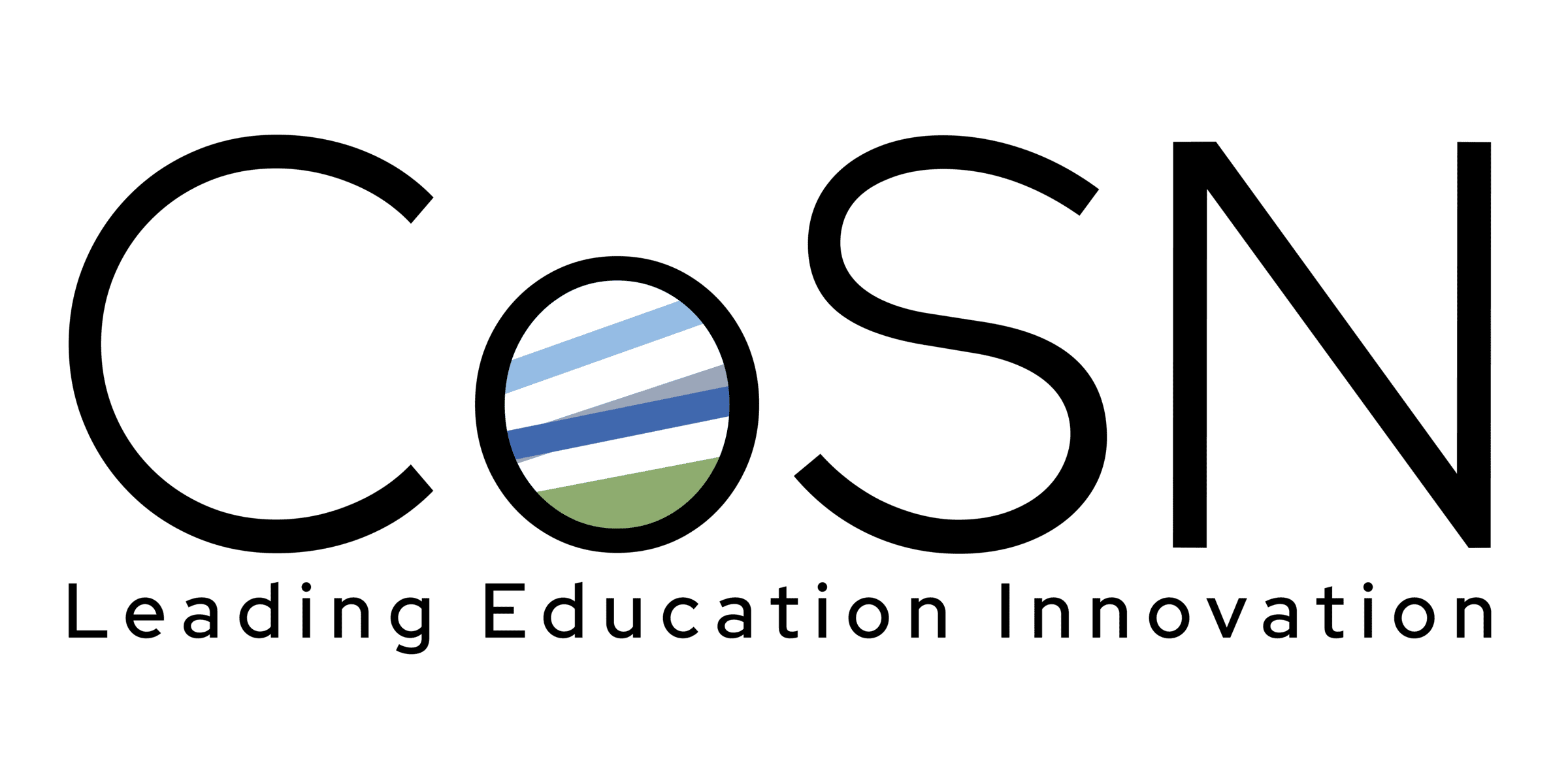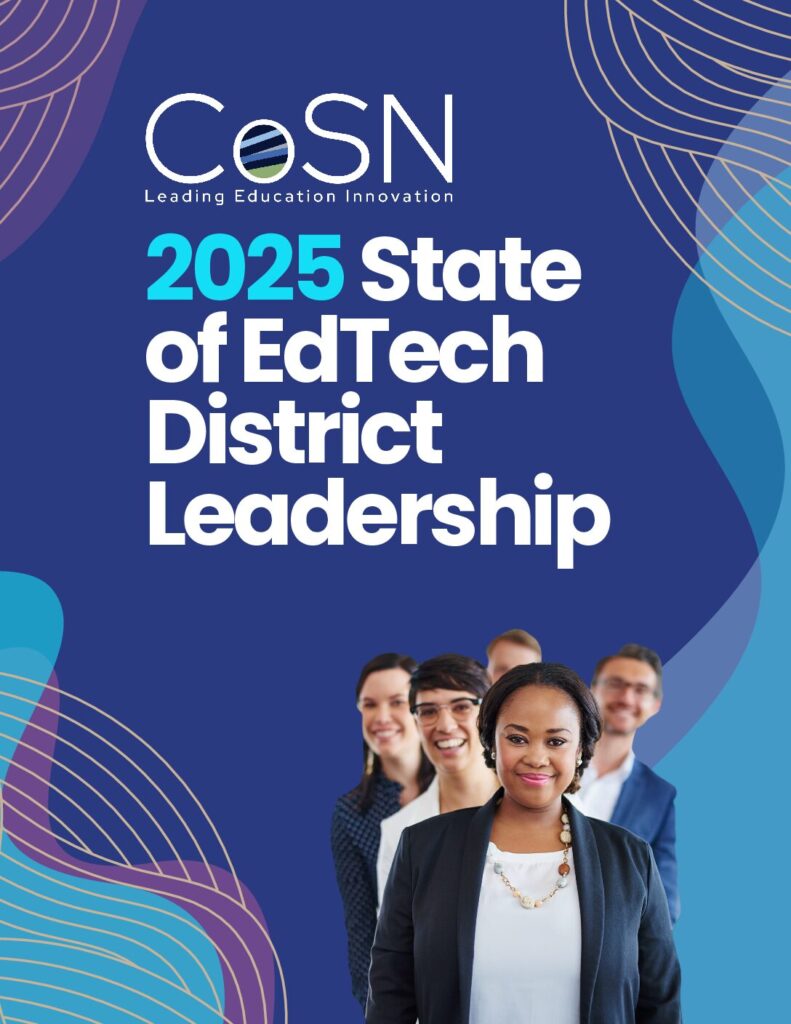CoSN conducts an annual survey to learn more about how the roles of K-12 EdTech Leaders are evolving. As districts continue to modernize their digital infrastructure, their role and importance expand. EdTech Leaders are integral to ensuring the safety of technology used for curriculum as well as technology used for building security. They help shape the learning environments intended to support all students, teachers, admins, and parents.
Now in its 12th year, the survey report provides important benchmarks on emerging AI technologies and evolving cybersecurity measures. It also provides valuable insights that can help inform the decisions of other education stakeholders —superintendents, school boards, and business officers—on priorities and budgets. Additionally, the survey findings guide CoSN’s resource and program development. Understanding districts’ needs enables CoSN to provide the support and the professional development that EdTech Leaders and their teams require to cultivate engaging learning environments.
Some Key Findings:
Digital Connectivity
If the Supreme Court finds that the administrative structure of the E-Rate program is unconstitutional, it will have a major and catastrophic impact on the vast majority of districts (74%) and will affect students in all areas—rural, town, suburban, and urban. Nearly half of respondents (48%) in cities describe the impact to be catastrophic. Only 2% of respondents reported the loss would not have any impact on their district. Support for off-campus broadband access is decreasing post-pandemic, with two-thirds (66%) of districts providing support, down from three-quarters (74%) in 2023.
Alarmingly, only 7% of districts report all their students have access to adequate bandwidth at home; support for ensuring home broadband for learning should instead be increasing, enabling every student to have the same access to learning opportunities.
Artificial Intelligence (AI)
The overwhelming majority (94%) of EdTech Leaders see AI’s potential for positive impact in education, with productivity the highest rated area. Generative AI (Gen AI) was ranked the top tech priority, with the vast majority (80%) of respondents working in districts with Gen AI initiatives.
Initiatives are proceeding with caution, as EdTech Leaders also have concerns about AI— primarily with how it can be used to create new types of cybersecurity threats and new risks to student data privacy. However, only 1% have taken the drastic measure to completely ban its use. It is more common for districts to allow or disallow AI based on use case. A majority (57%) of districts use or are exploring the use of tools to detect AI-generated answers in student work. A real challenge in education may not be policing the use of AI but creating assessments that enable students to demonstrate their preparedness to use AI.
Cybersecurity
Most school districts do not have dedicated funding to keep their networks and data secure. Districts typically use general funds to pay for their cybersecurity efforts (61%). The vast majority (78%) are spending cybersecurity dollars on monitoring, detection, and response tactics. For many districts (44%) cybersecurity monitoring is being outsourced. It is the most commonly outsourced IT function, likely due to the cost and difficulty of acquiring and maintaining in-house expertise. Perhaps because of these investments, EdTech Leaders overall do not perceive their districts to be at high risk for any of the threats listed on the survey. The biggest concern is phishing, with 27% assessing it as high risk to their network. The next-highest categories, each with just 13%, are the unauthorized disclosure of student data and ransomware attacks. These risk assessments do not appear take into account the value of K-12 student data to cyber criminals.1 While districts may be spending more money and focused on securing their systems, the risks are still high and higher than in the better-funded, better-resourced business sector. With current federal policy changes and federal funding cuts to the Multi-State Information Sharing and Analysis Center (MS-ISAC), which had provided cybersecurity training at no cost, cybersecurity risks are likely to increase.
Interoperability
The number one barrier to improving interoperability is not the lack of agreed- upon standards—which survey respondents ranked the least problematic— but a lack of understanding by leaders. The chaotic Covid period and ESSR funding resulted, as one respondent lamented, in “the purchase of software licenses with little thought and effort to integrate with other systems.” While there are procedures around the purchase of digital tools, free tools that are downloaded in an ad hoc manner put district data at risk. Increasingly, districts are adopting processes to vet free tools before they are integrated in their digital ecosystems. The most significant improvements are the practices for an “approved” apps list now used by 59%, compared to 42% two years ago. As districts modernize their infrastructure, interoperability of their digital tools becomes a critical consideration linked to data privacy and essential for operational efficiencies.
EdTech Leaders
While the demographic makeup of EdTech leadership remains relatively unchanged in many respects, this year’s data shows a shift in gender representation. The percentage of female respondents declined to 29%, compared to 37% in the previous year. This drop is notable, though it may be influenced by changes in survey participation, including fewer responses from leaders in rural districts and towns—groups that have historically shown more variability in representation. This degree of year-over-year change in the respondent pool is unusual and should be monitored moving forward.
Longitudinal data reveals another important shift: In 2015, a majority of EdTech leaders (58%) reported coming from an education background. In contrast, the majority (52%) in 2025 report a background in technology. This shift may reflect evolving job expectations, as the scope of EdTech leadership increasingly includes infrastructure, cybersecurity, and systems integration in addition to instructional support. Age data also points to changing dynamics in the field: 61% of female respondents are 50 or older, while 52% of male respondents are under 50.


